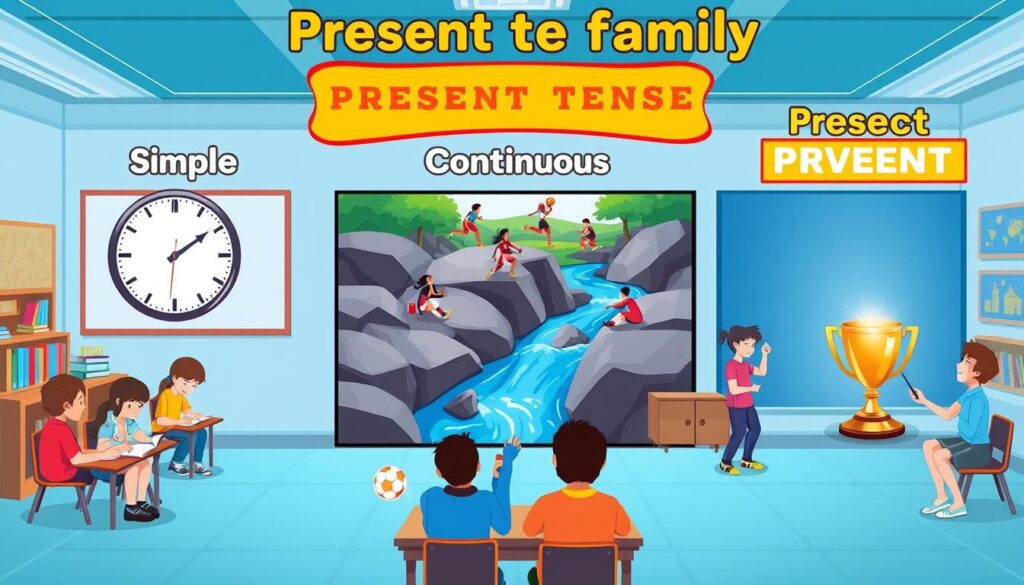Learning English well means knowing about verb tenses and their rules. This guide will help you understand tenses better. It’s for students, professionals, or anyone wanting to get better at English.

Key Takeaways
- Learn the basics of English tenses, like their structure and why they matter in talking and writing.
- Find out about the present, past, and future tense families. See how each is used differently.
- Get tips on using tenses right. This includes knowing about subject-verb agreement, time markers, and blending tenses.
- Improve your English skills and talk more clearly and confidently.
- Feel more comfortable with complex tense rules and avoid common mistakes.
The Fundamentals of English Tenses: A Quick Overview
Learning about English tenses is key for clear communication. Tenses show when and how an action happens. They help us share our thoughts and stories well.
What Makes Up a Tense
A tense has three main parts: the subject, the verb, and time clues. The subject is who or what does the action. The verb tells what’s happening. Time clues, like adverbs, tell us when it happens.
Why Tenses Matter in Communication
Tenses are crucial for clear talk. They tell us when things happen, now, then, or later. Using the right verb conjugation and time expressions makes our messages clear.
Basic Tense Structure Patterns
- Simple tenses: Subject + Verb (+ Time Expression)
- Continuous tenses: Subject + BE + Verb-ing (+ Time Expression)
- Perfect tenses: Subject + HAVE/HAS + Past Participle (+ Time Expression)
These basic patterns are the foundation of more complex grammar. They help us share the aspect and timing of our messages clearly.
Knowing the basics of tenses and their importance in talking can make your language more powerful. You’ll share your ideas more clearly and precisely.
Present Tense Family: Simple, Continuous, and Perfect Forms
Understanding the present tense family is key for clear English communication. This part covers the simple, continuous, and perfect forms. We’ll look at how to use them, how they’re formed, and when to use them.
The Present Simple Tense
The present simple tense talks about regular actions, universal facts, or common events. It often uses words like “always,” “usually,” or “every day.” For example, “I walk to work every morning.”
The Present Continuous Tense
The present continuous tense talks about things happening now or at the moment. It uses the present tense of “to be” and the present participle (verb + -ing). For instance, “I am working on a project right now.”
The Present Perfect Tense
The present perfect tense is for actions that are done but still matter today. It uses the present tense of “to have” and the past participle of the main verb. For example, “I have finished my homework for the day.”
| Tense | Usage | Formation | Example |
|---|---|---|---|
| Present Simple | Habitual actions, universal truths, regular occurrences | Base form of the verb | I walk to work every morning. |
| Present Continuous | Ongoing events or actions happening at the moment | Present tense of “to be” + present participle | I am working on a project right now. |
| Present Perfect | Completed actions with present relevance | Present tense of “to have” + past participle | I have finished my homework for the day. |
Mastering the present tense family helps you share regular actions, ongoing events, and actions that matter today. This makes your English communication clearer and more effective.

Past Tense Group: Mastering Time Gone By
Learning the English language starts with understanding the past tense. This part covers the past tense group’s complexities. We’ll look at regular and irregular verbs, common mistakes, and how to use the past perfect tense.
Regular vs Irregular Verbs
Verbs can be regular or irregular in the past tense. Regular verbs add “-ed” to the end, like “walk” becomes “walked.” Irregular verbs have unique past forms, like “go” becomes “went.” Knowing irregular verbs is key for using the past tense right.
Common Past Tense Mistakes
- Confusing “was” and “were”: I was at the park, but they were at the beach.
- Misusing “did” and “done”: I did my homework, not I done my homework.
- Incorrectly conjugating irregular verbs: I sitted on the bench, instead of I sat on the bench.
Past Perfect Usage Guidelines
The past perfect tense shows an action before another past event. It’s made with “had” and the verb’s past participle, like “I had finished my homework before class started.” Knowing when to use the past perfect is crucial for clear storytelling.
“The key to mastering the past tense is to practice, practice, practice. The more you immerse yourself in past tense usage, the more natural it will become.”
By diving into the past tense group, you’ll improve your storytelling. You’ll be able to describe actions, ongoing events, and event sequences clearly.
Future Tenses and Their Applications
In the world of English, knowing how to talk about the future is key. The future tenses – simple, continuous, and perfect – help us share plans and predictions. They show us what will happen in relation to other times.
The future simple tense is great for simple plans or guesses. Say “I will attend the meeting” or “The weather will be sunny tomorrow.” It’s perfect for quick future statements.
The future continuous tense talks about actions or events that will keep going at a future time. For example, “At this time tomorrow, I will be traveling to the office” or “By next month, the construction team will be working on the new building.”
- The future perfect tense is for actions that will finish by a certain future time. It’s useful for saying what will be done by then, like “By the end of the year, I will have finished my project” or “The team will have delivered the report by the deadline.”
- For planned actions, the future continuous tense is best. Think “I will be meeting with the client at 2 p.m. on Friday” or “The company will be launching its new product line next month.”
- For predictions, the future simple tense works well. Say “The stock market will rise in the coming quarter” or “The weather forecast indicates that it will rain tomorrow.”
Learning about future tenses helps you share your planned actions and predictions clearly. These tools make your messages strong and clear. Use them to improve your communication and make a strong impression.

“The future belongs to those who believe in the beauty of their dreams.” – Eleanor Roosevelt
Tenses and Their Rules: Essential Guidelines for Perfect Usage
Learning English tenses is key for clear communication. This section will guide you through subject-verb agreement, time markers, and mixing tenses. You’ll learn how to use tenses correctly.
Subject-Verb Agreement Rules
Subject-verb agreement is a basic grammar rule. Singular subjects need singular verbs, and plural subjects need plural verbs. Learn about exceptions, like collective nouns, and use these rules everywhere.
Time Markers and Tense Selection
Time expressions like “yesterday” or “next week” help pick the right tense. Pay attention to these markers to choose the correct tense. This skill makes your messages clear and easy to follow.
Mixing Tenses Correctly
In complex sentences, you might switch tenses to show different times. Make sure the transition is smooth and consistent. This way, you can talk about actions and events at different times clearly.
FAQ
What are the basic components of English tenses?
English tenses have three main parts: the subject, the verb, and time indicators. Knowing these is key to using tenses right and talking clearly.
Why are tenses important in English communication?
Tenses are crucial for clear communication in English. They show when something happens – now, in the past, or later. Using tenses correctly makes your messages clear and conversations smooth.
How do I form the present tense family in English?
The present tense family includes three forms: simple present, present continuous, and present perfect. The simple present is for regular actions, the present continuous for things happening now, and the present perfect for actions finished but still relevant.
What are the differences between regular and irregular past tense verbs?
Regular past tense verbs add “-ed” to the base form (like “walk” to “walked”). Irregular verbs don’t follow a pattern and must be learned by heart (like “go” to “went”).
How do I use the future tenses correctly in English?
The future tense family has three forms: simple future, future continuous, and future perfect. The simple future is for predictions and plans, the future continuous for ongoing future actions, and the future perfect for actions finished before another future event.
What are the key guidelines for consistent tense usage in English?
Key guidelines include keeping subject-verb agreement, using the right time markers, and mixing tenses in complex sentences. Following these rules makes your writing and speaking natural and clear.




